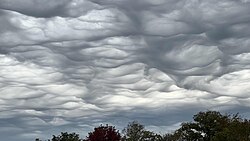Earth:Asperitas (cloud)
| Asperitas | |
|---|---|
 Asperitas over Dayton, Ohio in 2023 | |
| Genus | Altocumulus or Stratocumulus depending on height, as Asperitas is thought to be a cumuliform structure [1] |
| Species | Stratiformis |
| Variety | Opacus |
| Altitude | Below 2,000 (or higher with altocumulus) m (Below 6,000 -or higher with altocumulus- ft) |
| Appearance | Wavy undersurface |
| Precipitation cloud? | No, but may form near storm clouds. |
Asperitas (formerly known as Undulatus asperatus) is a cloud formation first popularized and proposed as a type of cloud in 2009 by Gavin Pretor-Pinney of the Cloud Appreciation Society. Added to the International Cloud Atlas as a supplementary feature in March 2017, it is the first cloud formation added since cirrus intortus in 1951.[2] The name translates approximately as "roughness".[3]
The clouds are closely related to undulatus clouds.[3] Although they appear dark and storm-like, they almost always dissipate without a storm forming. The ominous-looking clouds have been particularly common in the Plains states of the United States, often during the morning or midday hours following convective thunderstorm activity.[4][3]
Definition
According to International Cloud Atlas, Asperitas are defined as
Well-defined, wave-like structures in the underside of the cloud; more chaotic and with less horizontal organisation than the variety undulatus. Asperitas is characterised by localised waves in the cloud base, either smooth or dappled with smaller features, sometimes descending into sharp points, as if viewing a roughened sea surface from below. Varying levels of illumination and thickness of the cloud can lead to dramatic visual effects. Occurs mostly with Stratocumulus and Altocumulus.[5]
History
On June 20, 2006, Jane Wiggins took a picture of asperitas clouds from the window of a downtown office building in Cedar Rapids, Iowa, United States.[6] Soon after taking it, Wiggins sent her Cedar Rapids image to the Cloud Appreciation Society, which displayed it on its image gallery.[7] Since 2006, many similar cloud formations have been contributed to the gallery, and in 2009 Gavin Pretor-Pinney, founder of The Cloud Appreciation Society, began working with the Royal Meteorological Society to promote the cloud type as an entirely new type.[3] Wiggins' photograph was posted on the National Geographic website on June 4, 2009.[6]
In 2009 it was reported that Margaret LeMone, a cloud expert with the American National Center for Atmospheric Research had taken photos of asperitas clouds for 30 years, and considered it a new cloud type.[2]
On July 23, 2013, Janet Salsman photographed them along the South Shore of Nova Scotia, Canada. On October 28, 2013, an asperitas cloud layer formed over Tuscaloosa, Alabama, United States.[8] On July 7, 2014 asperitas clouds in Lincoln, Nebraska, United States, were filmed by Alex Schueth.[9] One of the most dramatic formations was captured by Witta Priester in New Zealand in 2005. The photo was posted by NASA as the Astronomy Picture of the Day and shows great detail, partly because sunlight illuminates the undulating clouds from the side.[10]
The 2017 edition of the World Meteorological Organisation (WMO)'s International Cloud Atlas included asperitas as a supplementary feature.[5] Pretor-Pinney gave an invited presentation at the WMO in Geneva for the launch of the revised Cloud Atlas, on World Meteorological Day 2017. He has worked with scientists at the Department of Meteorology, University of Reading on possible mechanisms for the formation of asperitas, co-authoring a paper published in the Royal Meteorological Society's journal Weather.[11]
See also
References
- ↑ "June 2009". The Cloud Appreciation Society. http://cloudappreciationsociety.org/june-09/.
- ↑ 2.0 2.1 "PICTURES: New Cloud Type Discovered?". National Geographic (National Geographic News): p. National Geographic. 2009-06-03. http://news.nationalgeographic.com/news/2009/06/photogalleries/new-cloud-pictures/.
- ↑ 3.0 3.1 3.2 3.3 "Asperatus: gathering storm to force new cloud name". London: The Guardian. 2009-06-02. https://www.theguardian.com/environment/gallery/2009/jun/01/2?picture=348217732.
- ↑ "New Cloud Type Discovered: 'Undulus Asperatus'". Meteorology News. 2006-04-28. http://www.meteorologynews.com/2009/06/06/new-cloud-type-discovered-undulus-asperatus.
- ↑ 5.0 5.1 "Asperitas" (in EN). https://cloudatlas.wmo.int/en/clouds-supplementary-features-asperitas.html.
- ↑ 6.0 6.1 MICHAEL J. CRUMB (2009-06-11). "Iowa Woman's Photo Sparks Push for New Cloud Type". Associated Press. http://www.physorg.com/news163990239.html.
- ↑ "Cloud Photos". The Cloud Appreciation Society. http://www.cloudappreciationsociety.org/gallery/index.php?showimage=1692.
- ↑ James Spann. "document formerly at plus.google.com". https://plus.google.com/108868884822043573742/posts/gBbvhByxGW8.
- ↑ Alex Schueth. "Undulatus Asperatus". https://www.youtube.com/watch?v=Jz7BgxrVmiQ.
- ↑ "APOD: 2013 February 27 - Asperatus Clouds Over New Zealand". https://apod.nasa.gov/apod/ap130227.html.
- ↑ Harrison, R. Giles; Pretor‐Pinney, Gavin; Marlton, Graeme J.; Anderson, Graeme D.; Kirshbaum, Daniel J.; Hogan, Robin J. (2017). "Asperitas – a newly identified cloud supplementary feature" (in en). Weather 72 (5): 132–141. doi:10.1002/wea.2996. ISSN 1477-8696. http://centaur.reading.ac.uk/69830/1/AsperitasPaper_revised2.pdf.
External links
 |

